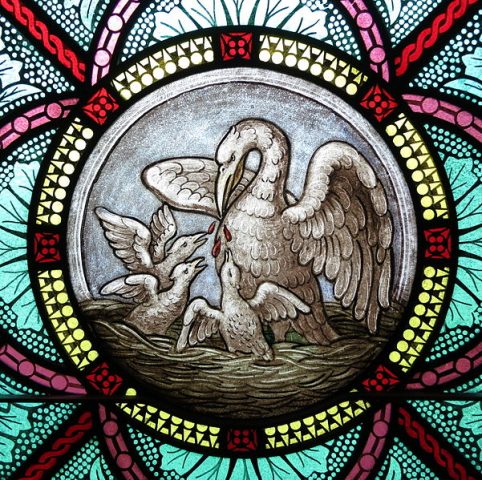The Symbolism of the Pelican for Corpus Christi, by Mary Kroner

BREAKING: Pro-Life Rescuer Paulette Harlow Sentenced to 24 Months in DC FACE Act Case, by Calvin Freiburge
June 1, 2024
The Most Holy Body and Blood of Christ, by Gayle Somers
June 1, 2024
All Saints Catholic Church (St. Peters, Missouri). Stained glass, sacristy, pelicans detail. Author Nheyob. I, the copyright holder of this work, hereby publish it under the following license: w:en:Creative Commons attribution share alike. This file is licensed under the Creative Commons Attribution-Share Alike 4.0 International license... You are free: to share – to copy, distribute and transmit the work
By Mary Kroner, Catholic Vote, May 31, 2024
Have you ever seen a depiction of a pelican in the stained glass windows of your church or in an adoration chapel you’ve visited?
Read on to discover the spiritual meaning of the pelican and how it is related to the Eucharist.
Before the birth of Christ, an ancient legend claimed that during a famine, a mother pelican would pierce her breast with her beak and feed her young with her own blood. An alternate version of the legend claimed that if a mother pelican’s young were dying, she would let them drink her blood to bring them back to health.
Early Christians noticed the parallels between the self-sacrificing bird and Christ, who gave His own blood for our salvation during His Passion – and continues to give us His Body and Blood in the Eucharist.
So those early Christians adopted the symbol of the pelican, which has since been used for centuries. References to a pelican are found even in the writings of Dante and Shakespeare.
The best-known reference is found in one of the five Eucharistic hymns composed by St. Thomas Aquinas for the Feast of Corpus Christi when it was first instituted.
The verse in Adoro Te Devote, or “Godhead Here in Hiding,” roughly translated from Latin, says: “Pelican of mercy, Jesus Lord, cleanse me, unclean, by Thy Blood, of which one drop is enough to wash the world of all sin.”
Jesuit poet Gerard Manley Hopkins translated the Angelic Doctor’s hymn into poetic English, rendering the following translation:
Like what tender tales tell of the Pelican
Bathe me, Jesus Lord, in what Thy Bosom ran
Blood that but one drop of has the pow’r to win
All the world forgiveness of its world of sin.




